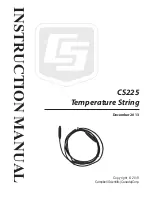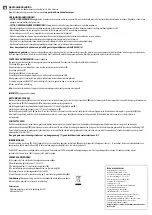29
MC-1 Digital Controller
S
ystem
Configuration
Once you have entered the distance to the nearest speaker, the MC-1
will automatically calculate the maximum allowable distance. The
display will show all of the speakers, each with a default distance setting
equal to your nearest speaker. Use SELECT and
▲
and
▼
to highlight
and enter actual distances for each speaker. The MC-1 rounds off
distance settings into discrete steps – choose the closest step to the
actual distance in these cases. If a speaker distance is further than the
MC-1 can accommodate, set it to the maximum allowable distance.
(This will vary, depending on your intial entry for NEAREST SPKR.)
A/V Sync Delay
A/V Sync Delay compensates for the delay that occurs when a video
processor, such as a scan rate converter, is used with the MC-1. Most
of these processors alter the original audio/video timing relationship by
adding delay to the video signal as it is processed. A/V Sync Delay
applies a corresponding delay to the audio signal to restore the original
audio/video timing relationship. It can also be used to compensate for
poorly mastered source material.
If your video material appears to be out of sync, engage A/V Sync Delay
in the LISTENER POSITION menu. With a video source running, adjust
the delay along its range with
▲
and
▼
.
Note that it is best to use a non-film source when setting A/V Sync Delay,
as film dialog added in post production may have poor timing relation-
ships.
Calibrate Panorama
Panorama works by canceling the sound going from each speaker to
the opposite ear. Its effectiveness is highly dependent on the geometry
of your front loudspeakers, the room and your listening position. The
correct timing of the canceling signal varies with the relative angle
between your main speakers.
Find a mono source, such as an announcer on FM radio or a mono film,
and listen for a tightly focused center image of speech or singing. If the
image is off-center, adjust the MC-1’s input balance controls. (The more
centered the monaural image, the better Panorama will work.)
Select CALIBRATE PANORAMA from the Listener Position menu to
display a sub-menu that allows you to turn on a calibration noise source,
configure the speaker angle, and adjust the listener position.
CAL NOISE is a special digitally generated signal to aid in calibrating the
Speaker Angle and Listener Position parameters. Note that in all cases,
sound will actually be produced by both front loudspeakers. The
adjustments affect the
perceived directionality of the sound.
Содержание MC-1
Страница 1: ...Owner s Manual MC 1 Digital Controller ...


















